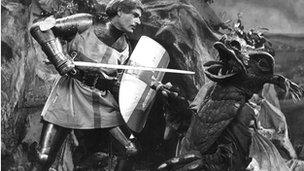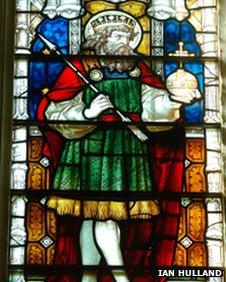St Edmund takes on St George for England's patron saint honour
- Published
St Edmund was King of East Anglia between AD 855 and 869
One is a Roman soldier who killed a dragon, the other is a former King of East Anglia whose decapitated head was reunited with its body with the help of a talking wolf.
Both have been patron saints, and both have supporters who vehemently back their respective cause to hold the title of patron saint of England.
But the support for St Edmund, who was killed in 869, is being given a fresh boost by campaigners who want him to reclaim the title currently held by St George.
It is not the first time a campaign has called for St Edmund to become the patron saint of England - a similar attempt made it to Parliament via a petition in 2006 only to be rejected by the Labour government.
But that was a time before widespread use of Facebook and Twitter, two mediums which #edmundforengland campaigners hope will tilt the public opinion in their favour.
"Edmund is an indigenous Anglo-Saxon who died in defence of the Christian religion, whereas St George is a foreigner," said Clive Paine, a Suffolk historian, author and lecturer.
'Extra holiday'
Edmund, King of East Anglia from 855 to 869 AD, was killed by Danish/Viking invaders, probably at Bradfield St Clare near Bury St Edmunds.
It is believed he refused to share power with what he regarded as heathen non-Christians and was tied to a tree, shot with arrows and beheaded.

St George is also patron saint of Georgia, Lithuania, Egypt, Romania and Portugal, among other places
Mr Paine said Edmund shared the title of patron saint of monarchy with Edward the Confessor from 1066 onwards, while St George became England's only patron saint in 1400.
The new campaign, which is being led by BBC Radio Suffolk's Mark Murphy and the Bury St Edmunds brewery Greene King, says the country needs a "unique" patron saint because George currently holds the role for 17 countries.
St Edmund's backers also want a new bank holiday to be added to the calendar in his honour.
The Very Reverend Frances Ward, Dean of St Edmundsbury Cathedral, said some of the connotations associated with St George were potentially damaging for England.
"St George started to grow in prominence after Richard the Lionheart prayed to him on crusade and then won a battle," she said.
"Do we want or need a patron saint in St George who constantly reminds us of the crusades, especially when the crusades still stir up bad feeling and hatred amongst the Muslim world?
"Much better to have a good king who died a martyr to his Christian faith instead of renouncing his crown to the Vikings."
Edmund objection
However, not everyone wants England's patron saint replaced.
John Clemence, president of the Royal Society of St George, said St George was "well established over many centuries".

St Edmund was peppered with arrows and beheaded
"St George is the patron saint of many other countries and, as such, he's a unifying saint," Mr Clemence said.
"All power to St Edmund's supporters, because it's good that they're taking interest in their local history, but I don't think the campaign has got much chance of success.
"There isn't a great tradition of patron saints being born in the country of which they are patron saint."
Another version of Edmund's death has him hiding under a bridge at Hoxne, Suffolk, where he was discovered by Danish forces.
The story goes that a wolf carried his head in its mouth. The animal looked after it until alerting loyalists with a call of "here, here, here".
Mr Paine said the Hoxne story is a myth which dates from the 1740s, but Edmund's remains were definitely taken to what became Bury St Edmunds before the abbey was established there in the 11th Century.
The bones disappeared during the Dissolution of the Monasteries by Henry VIII in 1539.
The last time a campaign was mounted, David Ruffley, MP for Bury St Edmunds, took a petition supporting St Edmund to Parliament.
Prime Minister Tony Blair's office thanked campaigners for the petition but said the government was not planning to change the patron saint of England.
During the campaign a train was named in his honour and St Edmund became the patron saint of Suffolk County Council.
- Published6 February 2013
- Published19 October 2010